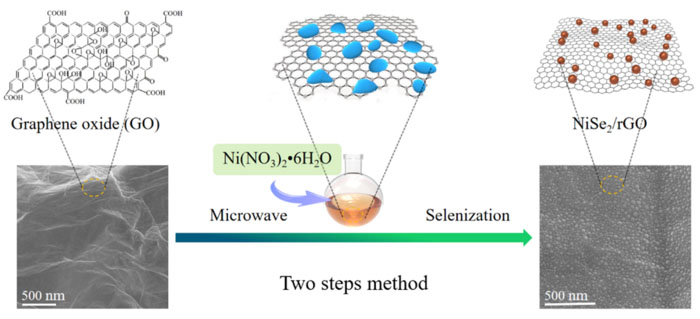| Jul 15, 2022 |
A novel graphene based NiSe2 nanocrystalline array for efficient hydrogen evolution reaction
(Nanowerk News) In the face of low electrolytic water splitting catalytic activity, the development of efficiency and stable electrolytic catalyst for hydrogen evolution reaction is critical necessary. Moreover, the rather high price with insufficient supply of noble mental namely platinum and palladium has become the obstacle of their large-scale applications.
|
|
A research group of Lixu Lei from Southeast University and Fajun Li from Suzhou University just reported a novel graphene based NiSe2 nanocrystalline array prepared through a two-step microwave and subsequent selenization treatment. They found their unique structural advantages —— the ultrafine uniform dispersion of NiSe2 nanocrystallines in the reduced graphite oxide as substrate has an additional synergistic effect on promoting the conductivity and stability.
|
|
The results were published in Frontiers in Energy ("In situ growth of NiSe2 nanocrystalline array on graphene for efficient hydrogen evolution reaction").
|
 |
| The two-step method for synthesis of NiSe2/rGO composite nanostructure. (© Higher Education Press Limited Company)
|
|
Nickel selenide electrocatalysts for hydrogen evolution reaction with high efficiency and low-cost, has favorable potential future application prospect. Nevertheless, the high overpotential and poor stability limited their practical applications. Carbon materials including graphene, carbon nanotubes etc. possess extraordinary thermal stability and electric conductivity, can be ideal protective skeleton structures of electrocatalysts. By combining the NiSe2 nanoparticles with graphene sheet in an in-situ growth manner assisted with microwave irradiation, the electrocatalytic performance of hydrogen evolution reaction was optimized remarkably in this work.
|
|
The electrocatalytic activity for hydrogen evolution reaction of the composite proven can reach up to 158 mV overpotential at 10 mA/cm2 and has an extremely stable performance in the 100 hours H2 production test. These results provide a useful idea for the development of newly high efficiency electrocatalyst for hydrogen evolution reaction.
|

